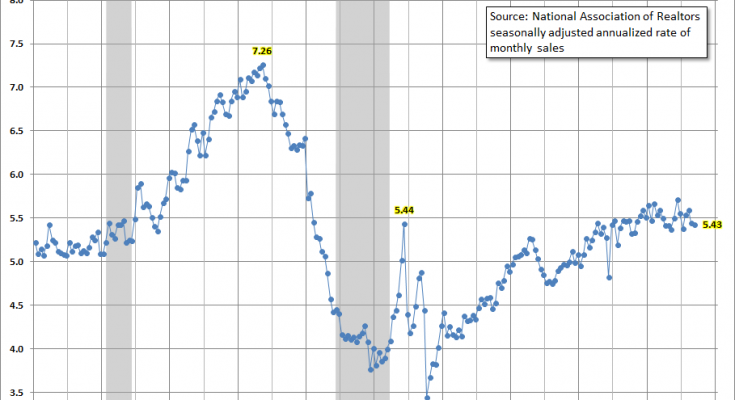This morning’s release of the May Existing-Home Sales decreased from the previous month to a seasonally adjusted annual rate of 5.43 million units. The Investing.com consensus was for 5.52 million. The latest number represents a 0.4% decrease from the previous month and a 3.0% decrease year-over-year.
Here is an excerpt from today’s report from the National Association of Realtors.
Lawrence Yun, NAR chief economist, says a solid economy and job market should be generating a much stronger sales pace than what has been seen so far this year. “Closings were down in a majority of the country last month and declined on an annual basis in each major region,†he said. “Incredibly low supply continues to be the primary impediment to more sales, but there’s no question the combination of higher prices and mortgage rates are pinching the budgets of prospective buyers, and ultimately keeping some from reaching the market.†[Full Report]
For a longer-term perspective, here is a snapshot of the data series, which comes from the National Association of Realtors. The data since January 1999 was previously available in the St. Louis Fed’s FRED repository and is now only available from January 2018. It can be found here.

Over this time frame, we clearly see the Real Estate Bubble, which peaked in 2005 and then fell dramatically. Sales were volatile for the first year or so following the Great Recession.
The Population-Adjusted Reality
Now let’s examine the data with a simple population adjustment. The Census Bureau’s mid-month population estimates show a 18.0% increase in the US population since the turn of the century. The snapshot below is an overlay of the NAR’s annualized estimates with a population-adjusted version.

Existing-home sales are 3.8% above the NAR’s January 2000 estimate. The population-adjusted version is 11.0% below the turn-of-the-century sales.
Existing-Home Sales Median Prices for Single Family Homes

